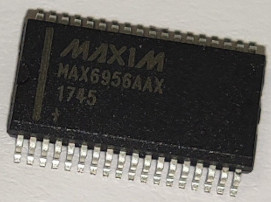MAX6956 I/O Expander
The MAX6956 component allows you to use MAX6956 I/O expanders (datasheet) in ESPHome. It uses I²C Bus for communication.
The max6956 exists in 2 versions 20 or 28 ports, depending on the packaging.
Once configured, you can use any of the 20 or 28 pins for your projects. Within ESPHome they emulate a real internal GPIO pin
and can therefore be used with many of ESPHome’s components such as the GPIO binary sensor or GPIO switch. Interrupt-on-change for inputs is not possible.
Pins can also be individualy configured as led driver and used with Light components. Current value can be set globaly or for each pin, through 16 possible levels. Driving RGB led requires 3 pins.
Any option accepting a Pin Schema can theoretically be used.
Component/Hub

The max6956 is an I²C Bus slave. Its address is configured using A0 and A1 hardware pins from 0x40 to 0x4F.
max6956:
- id: max6956_1
address: 0x40
i2c_id: bus_aConfiguration variables
id (Required, ID): The id to use for this
max6956component.address (Optional, int): The I²C address of the driver. Defaults to
0x40.i2c_id (Optional): The I²C Bus ID Defaults to
falsebrightness_global (Optional): Set the value of the current to be sink by all pins configured as led driver. Defaults to
0brightness_mode (Optional): Define if the current to be sink will be confgured globaly or per pin configured as led driver. Defaults to
global
Binary Sensor Example
max6956 pins can be use as binary sensor. Individual pullup are supported.
# Example configuration
binary_sensor:
- platform: gpio
name: "MaxIn Pin 4"
id: In_4
pin:
max6956: max6956_1
number: 4
mode:
input: true
pullup: true
inverted: FalseSwitch Example
max6956 pins can be use as switch.
# Example configuration
switch:
- platform: gpio
name: "MaxIn Pin 8"
id: In_8
pin:
max6956: max6956_1
number: 8
mode:
output: true
inverted: FalseLed driver Example
max6956 can control a constant-current sink to drive leds, with 16 equal steps from 1.5mA to 24mA.
# Example configuration : pin as led driver, current globaly
i2c:
id: bus_a
sda: GPIOXX
scl: GPIOXX
switch:
- platform: template
name: "Led"
id: MaxOut4
optimistic: true
turn_on_action:
- output.turn_on: maxOut_pin4
turn_off_action:
- output.turn_off: maxOut_pin4
number:
- platform: template
name: "Global brightness"
id: global_brightness
optimistic: true
min_value: 0
max_value: 15
initial_value: 1
step: 1
mode: slider
on_value:
- max6956.set_brightness_global:
id: max6956_1
brightness_global: !lambda return x;
max6956:
- id: max6956_1
address: 0x40
i2c_id: bus_a
brightness_mode: global
brightness_global: 5
#output to use
output:
- platform: max6956
pin: 4
id: maxOut_pin4
#led binded to output
light:
- platform: monochromatic
id: Light_1
output: maxOut_pin4# Example configuration : pin as led driver, current managed individualy (RBG led)
i2c:
id: bus_a
sda: GPIOXX
scl: GPIOXX
max6956:
- id: max6956_1
address: 0x40
i2c_id: bus_a
brightness_mode: segment
switch:
- platform: template
name: "Led Red"
id: MaxOut4
optimistic: true
turn_on_action:
- output.turn_on: maxOut_pin4
turn_off_action:
- output.turn_off: maxOut_pin4
- platform: template
name: "Led Green"
id: MaxOut5
optimistic: true
turn_on_action:
- output.turn_on: maxOut_pin5
turn_off_action:
- output.turn_off: maxOut_pin5
- platform: template
name: "Led Blue"
id: MaxOut6
optimistic: true
turn_on_action:
- output.turn_on: maxOut_pin6
turn_off_action:
- output.turn_off: maxOut_pin6
number:
- platform: template
name: "Number Red"
id: number_LedRed
optimistic: true
min_value: 0
max_value: 100
initial_value: 10
step: 1
mode: slider
on_value:
- output.set_level:
id: maxOut_pin4
level: !lambda return x/100;
- platform: template
name: "Number Green"
id: number_LedGreen
optimistic: true
min_value: 0
max_value: 100
initial_value: 10
step: 1
mode: slider
on_value:
- output.set_level:
id: maxOut_pin5
level: !lambda return x/100;
- platform: template
name: "Number Blue"
id: number_LedBlue
optimistic: true
min_value: 0
max_value: 100
initial_value: 10
step: 1
mode: slider
on_value:
- output.set_level:
id: maxOut_pin6
level: !lambda return x/100;
output:
- platform: max6956
pin: 4
id: maxOut_pin4
- platform: max6956
pin: 5
id: maxOut_pin5
- platform: max6956
pin: 6
id: maxOut_pin6
light:
- platform: rgb
id: Light_1
default_transition_length: 0.1s
gamma_correct: 1
red: maxOut_pin4
green: maxOut_pin5
blue: maxOut_pin6
